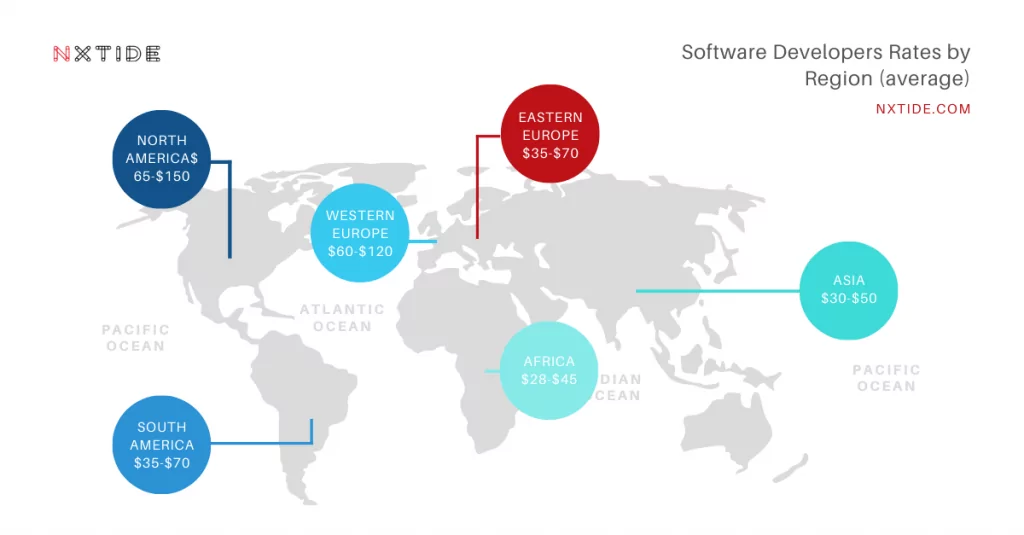How to Build a Successful Nearshore Software Development Team – a practical guide.

How to Build a Successful Nearshore Software Development Team? – a practical guide.
1) The software development teams.
Building a team requires critical care and extensive planning. That is even more so when you are trying to set up a software development team. There is a lot at stake when you are trying to build an effective team. Therefore, you need to put extra work and dedication into the work to create a team that can produce and sustain excellence.
Creating a solid nearshore software development team is beyond gathering a group of excellent developers. It requires way more than that. Every team member must be well accounted for and must have a reason for being a part of the team. You must ensure that you are deliberate about every team member and that their roles are crystal clear.
To help your software development team to be effective, we will look at some of the things you need to do and put firmly in place on the way. Next, we will discuss some specifics of the nearshore software development environment.
2) The structure of a software development team.
Let’s assume that you have a software product in mind and you need somebody to developed it for you. What do you do? Gather people that are capable of doing the job and kick your team to life! Sounds easy. If only it were that easy – but it isn’t.
Gathering capable developers and engineers is a crucial part of creating your team. However, the first step you need to take is to structure your engineering team for the project. That means you need to decide exactly the type of team you need to deliver on the project at hand.
Many companies make the mistake of trying to find the perfect engineer and then build a team around them. That is usually not a very successful strategy. The reason is that most projects have a specific structure that is required and it might not match with what the perfect engineer can offer.
Before you start to look for your first engineer, take the time to document the structure of your engineering team and determine what type of engineer you need. That will help you to find the right engineers and also set the ground rules for their work.
The primary aim of your engineering team structure should be to balance trade-offs and maximize effectiveness. Each team member should have valuable contributions that will augment the skills and assistance of the other team members. You must decide if you need more generalists or specialists on your team or even a mixture of the two (a hybrid team). The best way to make this decision lies in your project’s type, complexity, the time required, and budget. Let’s look at these types of teams in more detail to determine when to use each of them.
Technology team (Spacialists)
A technology team is a team that consists of specialists. These specialists are highly proficient in their chosen field. That makes them highly effective and quick to deliver on their tasks. They are usually suited for large projects that need in-depth knowledge and expertise.

Product teams can handle specific matters leveraging their knowledge and expertise, thus resulting in more efficiency and productivity. On the other hand, communication is not really their forte. Being narrow specialists, team members may lack the general understanding of their roles and this can lead to communication breakdown. When to choose?:
– Complex projects that require deep technical expertise: A technology team (or team of specialists) is more suited for projects that require deep technical knowledge. Therefore, if you feel your project is complex and challenging for less experienced team members to handle, you should opt for a technology team.
– A cloud-native project that needs to meet high scalability and availability requirements: Do you have a project that requires constant scaling to cater to increasing user base or customers? Or you have a project that requires capable hands to be readily available to handle possible issues? Your best option in such situations will be to build a technology team. The specialists have in-depth knowledge and will be ready to take whatever they need to do at any given time.
Product team (Generalists)
Generalists are Jack of all trades. They possess extensive knowledge and expertise on different subject matters relating to the products and company. Their main responsibility is to handle end-to-end solutions. The benefit of having them in your team is that they can provide a complete solution to the issue. Nevertheless, they have their drawbacks- they may find themselves not capable if a project requires specialized skills and expertise. When to choose: – End-to-end projects of moderate complexity: If you are running a project that doesn’t require (and mostly does not tend to require) specialist knowledge, generalists (or product teams) are the best fit. – Tight schedules when it’s better to integrate existing solutions instead of building them: Also, if your organization is running lean on available time, or your project requires integration instead of building from scratch, your best bet is a product team.

Matrix team (Spacialists)
Some situations require a combination of the two team structures above. In such cases, you can have a mix of both team structures. When this occurs, the resulting team structure is called a matrix team. A matrix team allows you to enjoy the benefits of both technical team structure and product team structure. While the generalists in the team concentrate on actualizing the team’s big picture achievable, the specialists on the team can focus on handling the specific details.
That way, the team’s strengths get a balance as the two ends balance out each other’s weaknesses. When to choose:
– Ideal for sharing talent and skills across departments: Matrix teams are ideal for ensuring a good share of talent and knowledge across the departments in your organization. It helps you have a team that sees the big picture and the little details, thereby ensuring no stone is left unturned.
– Cut costs – a matrix approach to projects is typically less expensive even though it sometimes tends to be more effective.
3) Define and plan core design, engineering, and product roles.
After you’ve decided on the right structure for your new software development team, the next step is to choose your team’s design, engineering, and product roles.
It is critical that software development teams clearly define their collective roles and responsibilities to allow for effective development. Below are the most essential business and technology-centered roles and responsibilities for any typical software development team.
Business Unit Manager
A business unit manager is a task manager of sorts. Their job is to make sure goals are being met and contribute to the company’s success in the long term. Some of their responsibilities include:
– initiating the project
– providing a clear project/product vision and strategic plan
– signing off-key milestones
Product Manager
Though smaller business teams may have the business manager act as a product manager, it’s important to distinguish their roles and responsibilities. A product manager is responsible for overseeing the success of a specific product, rather than the business as a whole. Key responsibilities of a product manager entail:
– translating the business unit manager’s project vision into a roadmap
– developing and defining the criteria and features of the product
Business Analyst
Business analysts work as liaisons between the technical and business side of development. They use data to improve processes and generate reports. Product managers and business analysts work together to further refine and define product features along with a technical lead to ensure they are prepared for development. Business analysts may:
– clarify product features
– resolve queries between the technical lead and product manager
– ensure developers aren’t disrupted by business fluff
Project Manager
Project managers reflect business managers but on the technical end. They make sure that the software development team completes their project on time and on budget. To accomplish this, they are in charge of: – scheduling, hosting, and documenting any relevant meetings. – securing the software development team with the necessary resources to deliver their project – monitoring the performance of the software development team and making helpful suggestions
Technical Lead
A technical lead acts in conjunction with the software development team, providing the corresponding project manager and business analyst with a key point of contact. They serve as a moderator between business management and software development and supervise the technical direction of the company. Their role involves: – taking responsibility for the entire technical project – implementing the coding standards and procedures that work best – detailing the structure of the project and meeting requirements
Developer Developers make up the bare meat of the software development team. Given that developers’ performance has a critical impact on product development and deployment, their time is spent wisely doing the following: – developing and deploying features – updating the technical lead and project manager with project reports
UI/ UX Designer
These designers will be thoroughly involved from start to finish. To be clear, user experience (UX) designers work on the behavior of a software product while user interface (UI) designers handle the graphic design or layout of the product. They are responsible for: – cooperating with the product manager to create a viable user experience that meets requirements – supporting the software development team throughout the build process
Quality Assurance / Product Tester Simply put, a quality assurance tester can make or break a product solely based on their understanding of feature requirements and resulting feedback. Those in this position have the final say on whether or not project/product features are up to par. Key responsibilities include: – certifying that developers meet the criteria and conditions defined in the requirements. – actively engaging with the development team and guiding them through the quality assurance process
4) Hire the right people for the right roles.
The hiring stage is essential. Even though having a good team doesn’t do all the work for your software development team, hiring the right people is very important. The quality of the team members is what makes up for the delivery ability of the group as a whole. Therefore, you need to ensure you hire the right people for your software development team.

However, the hiring process of every team (new or old) is never easy. And it’s even much harder to hire a software development team remotely based on CVs and Zoom interviews. Therefore, the hiring process can make or mar the project’s success even before operations start proper. Still, some qualities can help you see the ability of a candidate to become part of an excellent software development team. Let’s look at some of these qualities below.
Good software developers are team players
How successful your project will turn out depends largely on how effectively your team members communicate and interact with each other. To determine if a developer is an effective team player, look out for their experiences on achieving goals with teams they have worked within the past. Look at how they’ve handled corrections and opposing opinions and how much they recognize the contributions of other team members.
Hire people who are not limited to building excellent software. Ensure that they can work well and create excellence as a team and not just individually.
They’re proactive and take responsibility Good software developers don’t sit and wait for directives every time before they can get their job done. They, instead, are always willing and ready to take the initiative. They are very responsible, and they make effective plans about their days and tasks to be achieved. That makes it easy for them to deliver on projects.
They’re eager to push the limits of their comfort zone Good software developers have the ability and drive to learn new things on their own. They are self-starters and are always ready to pick up new skills. They do not shy away from tasks that require them to push beyond their limit. They are never satisfied with their current level and are always looking to break new frontiers.
Consider hiring remotely In your bid to hire great software developers, you should consider remote hiring. Remote working can be advantageous to your organization in many ways. For one, it can help you increase your productivity level while saving you some money. It also allows the worker to remove the stress of commuting to work daily while also helping them save money. Remote hiring also means you won’t have to worry about the location of your workers, thereby giving you access to talents from across different parts of the world while also reducing the rate of staff turnover due to the ease of operation.

5) Provide all necessary tools and a decent, creative work environment for your team.
TIf you want to set up a good software development team, you will need to ensure that you provide them with all they need to deliver effectively on their task. These include a conducive work environment and every necessary tool to enhance the team’s creativity.
If you do not create an enabling environment for your team, they will falter in delivering their task. It would help if you took the mental and livelihood of your team seriously, as that is what dictates how much team members can deliver on their job at the end of the day.
Provide your software development team with the required technology that can help them develop faster without becoming overwhelmed or frustrated. That ensures the team member’s mental health stays optimal always.
Source control and continuous integration tools These are examples of tools that can improve the efficiency of your software development team. Source control tools like Git allow for the flexibility your team needs. Gitflow, for example, is a Git workflow that helps your team maintain a continuous development and implementation of your software. It allows you to assign specific roles to branches of your team’s repositories while defining how and when the branches should interact. That makes it possible for different developers to work at a time while they merge their codes later.
Continuous integration tools work to ensure that your software continues to function after the addition or merging of new codes. They run tests on the software to determine if the new code does not adversely affect the software.
Use an End-to-End automated testing framework
End-to-end testing is where you test the entire application from start to finish. It involves ensuring that all integrated parts of the application function as expected and work together. End-to-end testing simulates real user scenarios, essentially testing how real users will use the application.
Automated tests prevent errors and regressions and improve developer productivity. They allow developers to detect problems before moving on to the next task, thereby fixing them while still on the task.

6) Boost the communication inside the team.
The benefits of effective team communication in the workplace cannot be understated. Your team needs to understand the importance of team communication because it is essential to their success.
Effective communication within the team will establish common goals among team members to achieve their goals. Frequent communication can help team members build a sense of belonging and strengthen interpersonal relationships.
Communication can improve organizational efficiency. When employees understand the work standards, they will be more willing to ask for help when needed, and the team will become more capable. Strong team communication will create understanding, and understanding will build strong relationships within the team.
Define roles and goals from the beginning
The more defined the roles of each team member are, the easier it is for them to take necessary actions. Most times, workplace miscommunication arises as a result of unclear distinctions of roles and responsibilities. Therefore, to improve the communication on your team and improve their overall productivity levels, it is pertinent that you create well-defined roles, responsibilities, and goals for the team members from the beginning of the team formation process.
Set a clear path on how to identify and resolve problems when they arise
There will be times when issues will arise among team members and within the team. To ensure that these situations don’t escalate into more severe cases, you must set a clear path to identify problems and resolve them at the same time when they arise.
Putting a conflict resolution and identification process and path in place for your team will ensure effective handling of problems whenever they arise. That also makes the process of operation a lot smoother.
Leveraging a common visual language to shrink feedback loops Waiting until the end of the sprint for feedback is too long. It would be best to understand that software development could see minor changes have a massive effect downstream. Therefore, you must create a common visual language to reduce the feedback loops. If developers do not maintain constant feedback early, developers might make assumptions that can make the project go off-course. The longer it takes for team members to provide feedback, the harder it will be to find possible problems and find solutions.
To ensure feedback loops become as short as possible, a common visual language will help develop mutual understanding among teams and team members. The visual language will facilitate sustained communication and effective coordination, thereby helping your team members make informed decisions to make the project a success.
Host retrospective team meetings Team meetings are necessary for every organization. It is always a time for a lot of issues, ideas, and observations to be tabled. Every team member will give their opinion about the situation and possible steps to take to ensure the project’s success.
A retrospective meeting is set up to allow you and your team members to look at your progress so far. You look at each step you’ve taken in the past and how actions have influenced the project’s current state. The retrospective meeting will help you shed more light on actions taken, thereby helping the team make better-informed decisions.
Celebrate team successes Acknowledging your team’s successes and celebrating them will help serve as a form of motivation to them. It enables you to show your team that their efforts do not go unnoticed and that they will be appreciated for their good deeds. Below are some best practices that will help you celebrate your team’s successes. – Use verbal praises: You can not underestimate the power of verbal appreciation. Therefore, using verbal compliments in public for your team (or team member) will make them feel recognized. When the praise is even more specific and instant, it achieves more. – Provide Written Praise: Sending emails to team members can also serve as a good way of celebrating team success. A simple email offering praise to the team members on their achievement will uplift their spirit and make them even more committed to influencing the future behavior and performance of the team. – Hold a Celebration Party or Event: organizing a party or mini-event to celebrate your team’s success also does a lot for the team’s motivation. Additionally, holding a party to celebrate your team’s success will avail them of an opportunity to interact with each other and foster friendship and better communication

7) Empower team ownership
To form a strong and wonderful team, you must ensure that top-down management is controlled. Without effective leadership at the top, only managers will be concerned with the organization’s or team’s objectives.
Below are ways that can help you empower team ownership among your team members.
Have trust within the team
The more trusting of each other the team members are, the more comfortable they get around themselves. That fosters a sense of family that creates an atmosphere where the team members see themselves as a vital part of a large family.
Therefore, to create trust within your team, help the team members to know each other’s histories, behaviors, and interests. Also, relying more on your team to make crucial decisions will foster a sense of ownership. Over time, each team member will have developed team ownership to make the team even stronger than it was.
Best practices:
– Show curiosity and expect the team to ask for help or feedback
– If somebody brings a challenging issue to your attention – encourage taking it to the team for discussion
– Demonstrate vulnerability and admit mistakes
– Make explicit that there are a lot of unknowns with complex work
Keep team up-to-date with the overall progress The more aware the team members are about the organization’s activities (and team), the more they’ll feel vital to the team. Therefore, if you want to empower team ownership among your team, keep them informed about the project’s overall progress.\
Best practices:
– Reference visual sprint board whenever discussing work with other team members
– Create a user story mapping board where the team can see the user’s journey through your product and where we are currently within the larger picture of the product roadmap
– Regularly ask, “How do we feel about our progress towards the Sprint Goal?” and “What do we think is the most important thing for us to focus on and achieve today?
– Work with team to identify where they see waste and bottlenecks by tracking WIP (work-in-progress) and how much time is spent waiting on others
Shared accountability of creating a done increment You must ensure that information is transparent among team members. That will make it easy for team members to discuss their progress, discover possible problems and collectively find solutions to the issues. Best practices: – Change the language to “we succeed as a team” and “we fail as a team.” – Hold individuals accountable by having them present progress on the area they worked on during Sprint demos
8) Always hold the software development team accountable
The more empowered your team is, the more the team will become more accountable for their tasks. Therefore, you should endeavor to provide the opportunity for your team to explain their obligations and how they fulfill those obligations.
Create an avenue that allows the team to share thoughts and opinions that can bring about improvement in projects. Also, ensuring that team members hold each other accountable will go a long way to ensure success.
Define what people are accountable for
Team members need to have clearly defined expectations to accomplish goals. Your organization may have some core responsibilities that align with the mission, core values, and purpose which you want the team to prioritize. Examples of such could be quality, excellence, or customer-centricity.
At some other times, you may want your team to be accountable while working on some short projects or take initiatives in some other cases. Whichever way, you should invest quality time to invest what you expect from your team.
Provide updates on the progress
Your team needs information to work effectively towards the goals. Information in this regard could be feedback from client surveys, ongoing project updates, or insights from relevant stakeholders. However, the most effective feedback that impacts the project significantly occurs between you and your team members.
While preparing your feedback, ask yourself if you have every relevant information, and the right data that is focused on performance. You can reinforce positive behaviors with performance-orientated data or discourage the negative ones which can ultimately boost the team productivity.
Recognize and celebrate progress
For every successful step that teams and team members take, ensure that they receive adequate recognition and immediate celebration. That will keep them on their toes to continue to deliver excellence, thereby increasing accountability.
Remove the ‘hero worship’
A new study conducted by Northwestern University revealed that when team members share previous experiences where they have successfully completed milestones together, the likelihood of winning increases for subsequent projects.
The keyword is ‘shared success’ which is more significant than individual success. As the team leader, you can reinforce purposeful collaboration and harmony by rewarding team-focused goals and not individual wins.
Now we will move to the second part of this article – the specifics of nearshore software development.
The global software developers shortage
The rapid development of technologies in the last 30 years has increased the demand for software development services exponentially. Many companies in developed countries are struggling to fill the positions. The global shortage of software engineers is estimated o be 1.8 million in 2022, as per the World Economic Forum’s “The Future of Jobs 2018” report.

The United States has about 500,000 open software development positions, but only about 200,000 computer science graduates each year. The UK has about 122,000 open positions and only about 42,000 computer science graduates. The software developers shortage is projected to grow to about 2.4 million by 2030 according to the UK’s National Skills Academy for Information and Communications Technology.
As the demand for software developers grows, the cost of hiring these professionals also increases. This puts a strain on budgets, which in turn delays projects or causes them to be shelved altogether. The global shortage of software engineers is a real challenge for companies in developed countries, it provides a unique opportunity for companies in developing countries. Nearshore software development teams or offshore development centers can fill the gap and provide high-quality software development services at a fraction of the cost of hiring developers in the United States or the UK.
10) What is the IT Outsourcing?
Outsourcing is the contracting of the operations and/or management of a company’s information technology (IT) functions to an external service provider. The provider can be an IT services company, a third-party vendor, or a business process outsourcing (BPO) company.
Outsourcing your project can be a great way to bring in new ideas and get more exposure. You might want to outsource your team if you can’t find the right person for the job or you need a specific skill set that’s not available in your locale. There are different outsourcing services available, and it is necessary to choose one that matches your needs and budget, as some may cost more than others.
Businesses outsource their work to companies in other countries, which are cheaper than their home country or have some skill sets that are not available locally. Outsourcing typically is centered on IT work, but it has expanded into other sectors over time too.Outsourcing is an effective way to cut costs, save time, and bring in fresh ideas that are not available in your company. It can also help you with time-consuming software development projects. At the same time, it allows you to focus on your core competencies, which will help increase your productivity.

The nearshore software development model.
Nearshore software development is the process of developing software in countries other than where the project is managed. They are outsourcing solutions for companies that need efficiency in delivering their projects, creating more profit, and providing better customer service. Nearshore software development is popular because it allows companies to save money while getting top-quality work done remotely.
Nearshore software development vs offshore software development.
The nearshore software development trend is growing rapidly as companies look for ways to reduce costs and get better quality work done. Nearshore software development has been defined as the process of developing software in countries other than where the project is managed, while offshore software development is the process of sending work to be completed in a foreign country.
The cost savings for nearshore outsourcing is primarily due to the cost of labor. In some cases, it may also be because of language barriers or cultural differences when dealing with people from other countries.
Offshore outsourced software development can have many benefits on running the project and how much risk they can take regarding time and money. Offshore software development has always been a popular thing in the IT industry, but it’s slowly becoming more common for companies to opt for the nearshore outsourcing model.
Nearshore outsourcing is a great solution for a company of every size. Smaller companies can build a single nearshore development team, while bigger ones can set up nearshore development offices composed of many multifunctional software teams.
Nearshore software development companies (vendors).
– Less time spent to travel – Different cultural approaches – More flexible and creative. – Higher standards of data security and trust
10 additional tips for building and managing successful nearshore software development team.
Successful nearshore software teams can operate fast and effectively to build a product that delivers real value for the customer. It is more difficult to hire and manage it than a typical product team on site. To be successful, your company must have a solid plan in place. We have already cover the general tips for managing modern software teams. Here are some addtional specific for nershore teams:
1) Create a clear, concise, and achievable vision for your product.
2) Provide training and ongoing support (as you never be able to get 100% qualifications you need)
3) Set up an efficient schedule with the team. (suitable for you and for them!)
4) Develop the right culture to attract the best talents (conditions, friendly atmosphere, values)
5) Facilitate an Agile approach to move faster with the project and have more control in case of problems.
6) Give autonomy to your team members over their work.
7) Boost communication tools such as Slack and Trello for collaboration and communication.
8) Try to inspire the team with your product and company vision.
9) Celebrate short-term successes and key milestones during the project.
10) Build the bond with team members as you’d do in managing an on-site team.
The benefits of using nearshore software development companies.
Nearshoring software outsourcing is an effective way to get your project done while saving on costs. But what are the benefits of using nearshore software development services provided by local IT partners?
Here are some of the benefits:

1) The companies do work you have no time or resources to do yourself. This lowers your risk from the beginning of the project.
2) Effectiveness – nearshore developers are usually more agile and hard-working than in-house staff.
3) The cost of managing a remote team is much lower than managing an onshore team.
4) Nearshore companies can be flexible and adaptable to your changing needs and business goals.
5) It can provide a variety of skills for short-duration projects with tight deadlines, which can help boost your revenue and profits.
6) If you need to scale up your work, the nearshore option will help you meet that requirement quickly without the need to raise capital from investors or shareholders.
7) You don’t have to worry about finding the best candidates for your job opening.
Finding a quality nearshore software development company.
As we mentioned before – there are plenty of companies offering HR, outsourcing services, or simple staff augmentation. But only a few ones will fulfill the criteria for a true nearshore software development company. Building software teams requires time and much deeper knowledge than only human resources. It includes also know-how from disciplines like IT, business partnerships, office management, process building, financial operations. Nearshore software companies should be considered long-term partners rather than another vendor that could be replaced with others. So how to find the right ones?
Some screening filters to find a quality nearshore software development partner:
– An experienced team of software developers, project managers, and HR team (Software development background of the owners would also be desired)
– Experienced in building software development teams, nearshore development centers from the scratch
– Reasonable rates – both parties should be happy with the cooperation
– Strong technical capabilities and a track record of delivering teams on time and within budget.
– References from previous customers with a track record of successful projects – Additional support services after the team set up (ability to scale the team)
– Well developed network of business, HR partners allowing to recruit faster – A healthy financial situation that allows the partner to operate without delays
– An up-to-date project management process, including clear communication every step of the way, so that you can always keep tabs on your project’s progress.
About Us:
NxTide is a specialized company focusing on building local, Software Development Teams or larger Software Development Centers in major cities in Poland. We take care of all recruitment and quality control processes making it faster and more cost-effective for you. Here is some more information about our expertise: – Over 7 years experience in creating a variety of software development teams – Over 60 teams and 300 engineers successfully hired and deployed – Several dedicated HR and IT Project Management Teams acting on your behalf.
Please take a closer look at a dedicated and flexible offer we have prepared based on market needs:
1) Software Development Teams: dedicated to clients looking to expand their software development teams or create small remote teams from scratch.
2) Offshore Development Center: dedicated to larger and permanent projects. We’ve implemented the innovative Build Operate Transfer model to make the whole process faster, more efficient, and transparent.
3) Nearshore Software Development Office: dedicated to larger and permanent projects within the same region, continent.

Create a Nearshore Software Development Office with NxTide
Over our 7-year company activity we have helped many US and EU companies to successfully build Software Development Teams and Software Development Centers in a variety of locations in Poland.
Interested? – Let’s discuss your case on a call.
Marcin Dziedzic, CEO of Pragmatic Coders and NxTide.

Kraków
Over 0,8M population, 13% of total IT Engineers supply

Warsaw
Over 1,8M population, 24% of total IT Engineers supply

Wrocław
Over 0,7M population, 12% of total IT Engineers supply

Katowice
Over 1,8M population, 9% of total IT Engineers supply

Poznań
Over 0,7M population, 8% of total IT Engineers supply

Łódź
Over 0,7M population, 7% of total IT Engineers supply

Gdańsk
Over 0,6M population, 6% of total IT Engineers supply

Bydgoszcz
Over 0,5M population, 4% of total IT Engineers supply
Other related articles that might interests you:

When and how to use the Build Operate Transfer model in software development?
Home When and how to use the Build Operate Transfer model in software development? The Build Operate Transfer model (BOT) in…

The Advantages and Disadvantages of Java Software Development.
Home The Advantages and Disadvantages of Java Software Development. Very few things can remain relevant for over two decades, but…

How to Build Successful Offshore Software Development Teams for Your Business?
Home How to Build Successful Offshore Software Development Teams for Your Business? The software development process is complex and time-consuming.…
